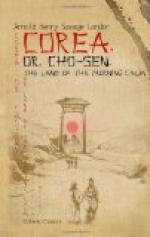The wedding ceremony in Cho-sen is simple. It is not celebrated as with us, in the house of the bride, but in that of the bridegroom. The bride it is, who—carried in a palanquin, if a lady of means and good family, or on pony or donkey back, if she belongs to the lower classes—goes, followed by parents, relations and friends, to the house of the bridegroom. Here she finds assembled his friends and relations, and, having been received by the father of the bridegroom, she mounts a small platform erected for the purpose in the centre of the room and squats down. Her father follows suit, placing himself just behind her. The bridegroom, apparently unconcerned by the serious change in his life that is in prospect, sits on his heels in front of her on the platform. A document is then produced and unrolled, on which, in hundreds of fantastic Chinese characters, it is certified that the performance taking place is a bona-fide marriage between Mr. So-and-so and the daughter of So-and-so; the weaker sex, as we have already seen, not being entitled to a personal name. The two contracting parties having signed the document, the fathers of the bride and bridegroom and the nearest relations, follow suit. If, as happens in many cases, the woman is able neither to read nor write, she can make “her mark” on the roll of paper in question; and I must confess that of all the ingenious marks I have seen, this one is the most ingenious of all. If she be a lady of rank and illiterate, her little hand is placed on the paper and the outline drawn round the fingers and wrist with a fine brush dipped in Chinese ink; but if she happens to have no blue blood in her veins, and is, therefore, of less gracious manners, the simpler process of smearing her hand with black paint and hitting the document with it is considered to render the ceremony more impressive. A more or less vivid impression of the wife’s fleshly seal having been affixed in this way to some part or other of the document according to her skill in aiming, the two unfortunates resume their dignity on the platform, sitting face to face without a word or motion. The bridegroom then makes four grand bows to his wife, in sign of resignation or assent, I suppose; and she returns two, while she treats her father-in-law with double that amount of reverence. This constitutes the marriage ceremony proper, but much further bowing has to be gone through by both the parties to each of the people present, who, accompanying their wedding-gifts of birds and fish with pretty compliments, come forward, one by one, to the platform and drink the health, happiness and joy of the wedded pair. It is the duty of the bride to remain perfectly mute and apparently unconcerned at all the pretty speeches addressed to her by the bridegroom and his friends until the nuptial-chamber is entered later in the evening. Previous to this, however, the bridegroom is taken away into the men’s apartment, while, on the other hand, the wife is led




